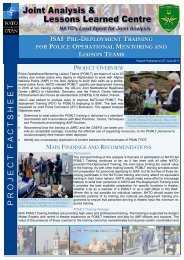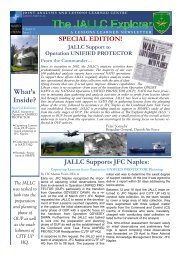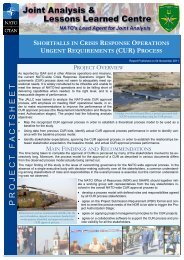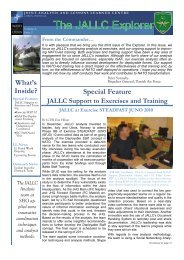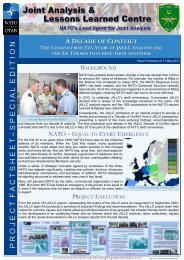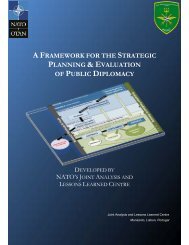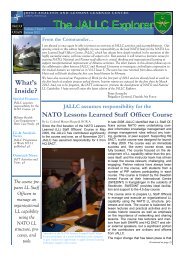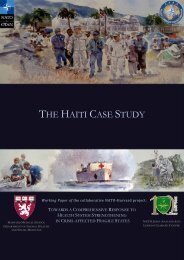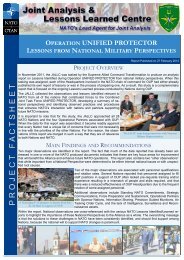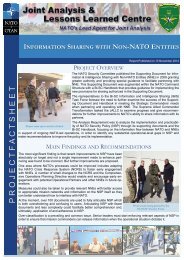Final evaluation Netherlands participation in ISAF 2006 - 2010
Final evaluation Netherlands participation in ISAF 2006 - 2010
Final evaluation Netherlands participation in ISAF 2006 - 2010
Create successful ePaper yourself
Turn your PDF publications into a flip-book with our unique Google optimized e-Paper software.
At the end of 2005, the Afghan authorities had little to no <strong>in</strong>fluence <strong>in</strong>considerable parts of the prov<strong>in</strong>ce. The security situation was poor and the<strong>in</strong>surgents had extensive freedom of action. Dur<strong>in</strong>g the mission, the<strong>Netherlands</strong> succeeded <strong>in</strong> provid<strong>in</strong>g greater security for the populationcentres and thus for the majority of the people of Uruzgan. There was greatfear among the population that the <strong>in</strong>surgents would return. The protectionwhich the <strong>Netherlands</strong> was able to provide to the civilian population was attimes temporary and localised, depend<strong>in</strong>g on the situation. Not always werethere sufficient numbers of (Dutch) <strong>ISAF</strong> troops or ANSF personnel availablefor that protection to be permanent.In the first years of the <strong>in</strong>k blot strategy, operations at the high end of thespectrum of force were necessary on a regular basis. Confrontationsbetween the <strong>in</strong>surgents and <strong>ISAF</strong> troops led to casualties among our ownunits and among the local population. The comb<strong>in</strong>ation of, on the one hand,the high level of force and, on the other, operations <strong>in</strong>volv<strong>in</strong>g social patrolsand outreach activities by mission teams demanded a high level of flexibilityfrom the personnel. The units proved to be very capable of carry<strong>in</strong>g outthese activities, even if they were conducted close together <strong>in</strong> terms of timeand space. This had a positive impact on the effectiveness of theoperations. The freedom of movement of the PRT and the civilian expertsand diplomats was limited by the security situation. With<strong>in</strong> the <strong>in</strong>k blot, too,the PRT sometimes required force protection from the Battle Group, butthat protection was not always available. At times this hampered theactivities of the PRT. The activities of the American, Australian and Dutchspecial forces outside the <strong>in</strong>k blot were essential <strong>in</strong> reliev<strong>in</strong>g the pressureon the <strong>in</strong>k blot.ResultsOw<strong>in</strong>g <strong>in</strong> part to Dutch efforts, the presence of the Afghan army <strong>in</strong>creased<strong>in</strong> the prov<strong>in</strong>ce of Uruzgan. In <strong>2006</strong>, the Afghan army’s presence <strong>in</strong> theprov<strong>in</strong>ce was very limited and the police apparatus was weak. From 2007,more attention was focused on build<strong>in</strong>g up a properly function<strong>in</strong>g policeapparatus. In <strong>2010</strong>, the effective size of the 4 th brigade <strong>in</strong> Uruzgan wasapproximately 3,200 personnel. In the period up to <strong>2010</strong>, the <strong>Netherlands</strong>tra<strong>in</strong>ed around 1,000 police officers.With the gradual expansion of the <strong>in</strong>k blots, an <strong>in</strong>creas<strong>in</strong>g number of thepopulation were brought under the protection of <strong>ISAF</strong> and the Afghanauthorities, despite the pressure from and <strong>in</strong>fluence of the <strong>in</strong>surgents.The Dutch <strong>in</strong>k blot strategy was based on the premise that after a certa<strong>in</strong>period of time, the Afghan security services would be able to ma<strong>in</strong>ta<strong>in</strong>security <strong>in</strong> the relatively safe areas largely without assistance. That wouldfree up capacity to expand the <strong>in</strong>k blot further. The <strong>in</strong>dependence of theANSF envisaged <strong>in</strong> the Article 100 letter, <strong>in</strong>clud<strong>in</strong>g the transfer ofresponsibility of security <strong>in</strong> the populated areas, was not achieved dur<strong>in</strong>gthe mission, however. This laid extra claims on the Dutch <strong>ISAF</strong> units.The <strong>in</strong>k blot areas were expanded over a period of four years. In <strong>2010</strong>, thearea controlled by <strong>ISAF</strong> and the Afghan army and police <strong>in</strong>cluded more thanhalf of the population of the prov<strong>in</strong>ce. Economic activity <strong>in</strong>creased andNGOs found their way to the prov<strong>in</strong>ce. The improved security situation is,however, fragile and not irreversible.6.2.4 Sub-conclusion: Good governanceObjectivePage 101 of 133




